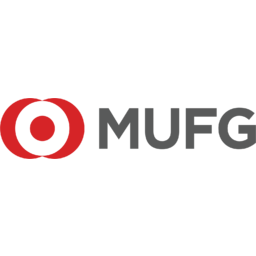
P/E ratio for Mitsubishi UFJ Financial (MUFG)
P/E ratio as of April 2024 (TTM): 10.7
According to Mitsubishi UFJ Financial's latest financial reports and stock price the company's current price-to-earnings ratio (TTM) is 10.657. At the end of 2022 the company had a P/E ratio of 27.5.
P/E ratio history for Mitsubishi UFJ Financial from 2001 to 2023
PE ratio at the end of each year
| Year | P/E ratio | Change |
|---|---|---|
| 2022 | 27.5 | 334.18% |
| 2021 | 6.32 | -41.93% |
| 2020 | 10.9 | -15.28% |
| 2019 | 12.9 | 125.85% |
| 2018 | 5.69 | -54.63% |
| 2017 | 12.5 | |
| 2007 | -115 | -262.62% |
| 2006 | 70.7 | 288.63% |
| 2005 | 18.2 | -9.82% |
| 2004 | 20.2 | 350.33% |
| 2003 | 4.48 | -117.26% |
| 2002 | -25.9 | 63.11% |
| 2001 | -15.9 |
P/E ratio for similar companies or competitors
| Company | P/E ratio | P/E ratio differencediff. | Country |
|---|---|---|---|
 Northeast Bank NBN | 9.09 | -14.73% | 🇺🇸 USA |
 National Bank Holdings
NBHC | 10.1 | -5.37% | 🇺🇸 USA |
How to read a P/E ratio?
The Price/Earnings ratio measures the relationship between a company's stock price and its earnings per share. A low but positive P/E ratio stands for a company that is generating high earnings compared to its current valuation and might be undervalued. A company with a high negative (near 0) P/E ratio stands for a company that is generating heavy losses compared to its current valuation.
Companies with a P/E ratio over 30 or a negative one are generaly seen as "growth stocks" meaning that investors typically expect the company to grow or to become profitable in the future.
Companies with a positive P/E ratio bellow 10 are generally seen as "value stocks" meaning that the company is already very profitable and unlikely to strong growth in the future.